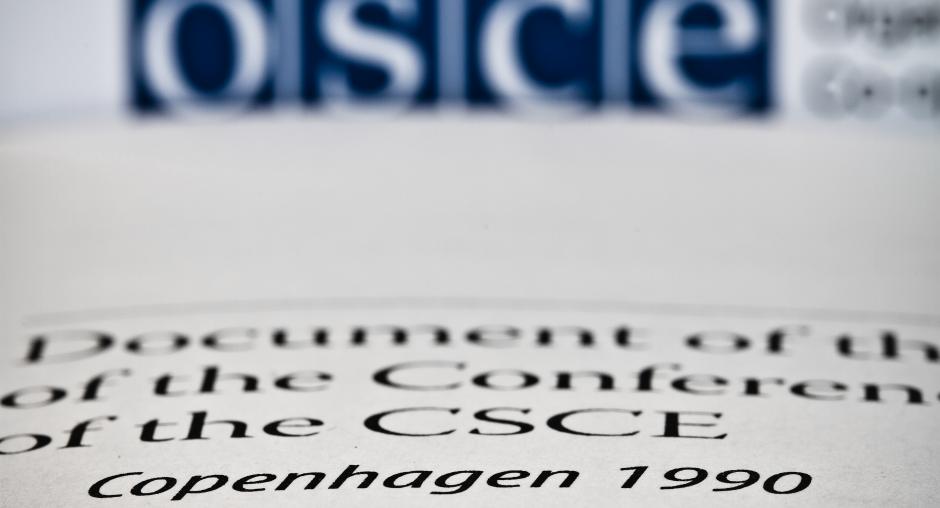Living up to the legacy? Key OSCE human rights document turns 20
Twenty years ago, representatives of the participating States of what was then the Conference on Security and Co-operation in Europe met in the Danish capital of Copenhagen, where, after more than three weeks of negotiations, they reached an agreement on a landmark document that would become the fundamental rulebook for the entire OSCE region in the broad areas of democracy and human rights.
On 10-11 June, Copenhagen will again play host to representatives of the Organization's participating States, this time to mark the 20th anniversary of the adoption of the Copenhagen Document and to take stock of compliance with the commitments that were agreed in 1990.
While the upcoming conference will largely be forward-looking, it is worth taking a look back on the original Copenhagen conference to get a sense of the impact that this document has had on the Organization and all its participating States.
New commitments for a new era
The Copenhagen conference took place at a time of historic change in Europe. The Berlin Wall had fallen the previous autumn, and the map of the continent would soon be redrawn, as a wave of mostly non-violent revolutions in the Communist bloc countries of Eastern Europe brought down the Iron Curtain. And one of the Document's major signatory states, the Soviet Union, would soon cease to exist, being succeeded within the Organization by the Russian Federation, while the other 14 former Soviet republics joined as independent states.
"There was great enthusiasm among the [O]SCE countries after the Berlin Wall came down in 1989 to help emerging states fulfill their democratic aspirations," says Audrey Glover, a former ODIHR Director, who was at the conference. "Copenhagen provided an opportunity for all states in the region, both established and fledgling democracies, to work together to turn those aspirations into clear standards that tied together concepts like democratic elections, the rule of law and respect for human rights."
It was the existence of a far-reaching aspiration for democratic change that provided the space needed for the Copenhagen commitments to come about.
"Unlike international treaties, these new politically binding norms didn't have to be ratified by national parliaments to take effect," explains Glover. "This allowed the OSCE to play an avant-garde role in setting standards after the Cold War."
Indeed, countries agreed to common standards that would have been unthinkable just a few years before.
One of the key achievements of Copenhagen is that it introduced a set of far-reaching commitments on how to conduct democratic elections and laid the groundwork for the Organization's future activities in the area of election observation.
"The obligation to invite international observes to monitor elections was groundbreaking at the time," says Nicolas Kaczorowski, Head of ODIHR's Election Department. "By establishing this standing invitation, Copenhagen introduced one of the OSCE's key notions, namely that issues related to human rights and democracy are of concern to all participating States because they have an impact on the security of the entire region."
Copenhagen also introduced a new approach to the concept of the rule of law, clarifying that the notion goes beyond formal respect for the law. The rule of law, as defined in Copenhagen, means "justice based on the supreme value of the human personality and guaranteed by institutions providing a framework for its fullest expression".
"It's fair to say that Copenhagen was something of a landmark with respect to the rule of law, as it went much further than many other international documents at the time in linking the rule of law with human rights and democracy," says Carsten Weber, Head of ODIHR's Rule of Law Unit. "Basically, the OSCE's participating States agreed that there is only one system of government that can guarantee the effective protection of human rights, and that's pluralistic democracy based on the rule of law."
The Document also includes the rights of national minorities, a subject garnering little attention prior to Copenhagen. Indeed, before 1990, there was little, if any, international agreement on the specific rights of minorities.
The Document states that belonging to a national minority is a "matter of a person's individual choice".
"To quote one of my predecessors, former High Commissioner Max van der Stoel, 'the existence of a minority is a question of fact and not [of] definition'," says current OSCE High Commissioner on National Minorities Knut Vollebaek. "Copenhagen went much further than existing documents in providing an entire catalogue of minority rights and committing participating States to protect the rights of ethnic, cultural, linguistic and religious minorities living on their territory."
Following up and looking ahead
The need for follow-up is something that often gets lost in public discussions about the OSCE. According to ODIHR Director Janez Lenarcic, follow-up is the essence of much of the OSCE's work. "All of our work in this Organization is based on the commitments that the participating States have undertaken. It is our job to monitor how they are living up to those commitments and to offer assistance where it is needed."
Twenty years after the original Copenhagen conference that revolutionized much of the Organization, the next meeting in Copenhagen will be more about business as usual. "We don't need to revolutionize the Organization again," says Lenarcic. "The framework for peaceful, secure and democratic societies exists, and it was largely established in Copenhagen twenty years ago. As an Organization and as individual states, we simply need to make every effort we can to live up to the promise of that era."

